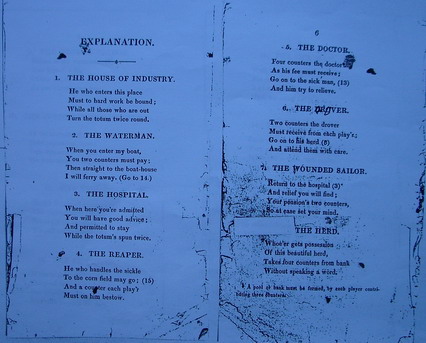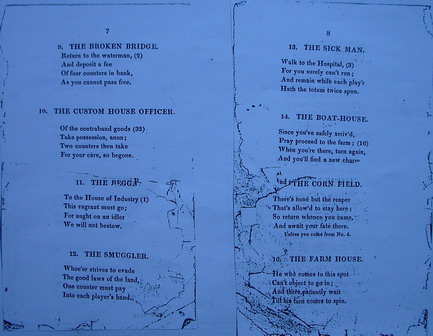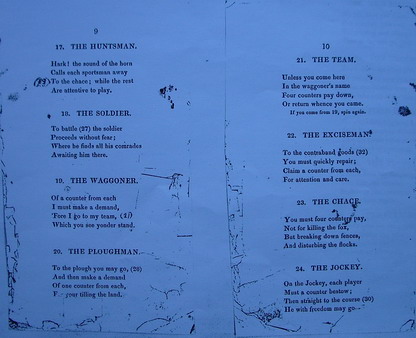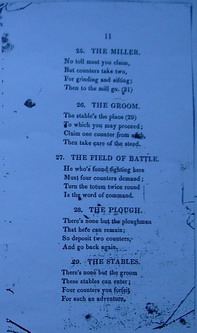Giochi dell'Oca e di percorso
(by Luigi Ciompi & Adrian Seville)
(by Luigi Ciompi & Adrian Seville)

|
Giochi dell'Oca e di percorso
(by Luigi Ciompi & Adrian Seville) |

|
 |

Torna alla ricerca giochi (back to game search) |
 |
| Every Man to his Station. A New Game. | ||
 |
Versione stampabile
 |
Invia una segnalazione

|
      |
primo autore: | Anonimo |
| secondo autore: | Wallis | |
| anno: | 1825 | |
| luogo: |
Inghilterra-Londra |
|
| periodo: | XIX secolo (1°/4) | |
| percorso: | Percorso di 32 caselle numerate | |
| materiale: | carta incollata su tela (engraving on paper with linen backing) | |
| dimensioni: | 397X506 | |
| stampa: | Litografia colorata a mano (hand-coloured engraving) | |
| luogo acquisto: | ||
| data acquisto: | ||
| dimensioni confezione: | ||
| numero caselle: | 32 | |
| categoria: | Religione, Diritto e Morale | |
| tipo di gioco: | Gioco di percorso | |
| editore: | Published by E. Wallis 42 Skinner S.t and Islington | |
| stampatore: | Published by E. Wallis 42 Skinner S.t and Islington | |
| proprietario: | Collezione E. C | |
| autore delle foto: | E. C. | |
| numero di catalogo: | 1348 | |
| descrizione: |
Gioco di 32 caselle numerate. REGOLE: non riportate sul tavoliere. CASELLE: mute. REFERENZA 1 "Every Man to his Station. A New Game". (V&A Museum). The game would be played with a teetotum, markers and counters. It has 33 illustrated playing spaces showing various houses, cottages and a windmill. Also portrayed are various occupations including a boatman, soldier, farm worker and jockey. The end space of the game in the centre of the sheet shows an illustration of five boys seated around a table. They appear to be playing a version of this very game. Physical description Design: ENGRAVING, COLOURED BY HAND; 8 SECTIONS MOUNTED ON LINEN N°of squares: 33 Squares illustrated: all Square numbering: none Squares titled: none Subject of starting square: ? Subject of ending square: 5 boys playing the game Place of Origin: London Date: ca. 1825 Artist/maker: Wallis, Edward Materials and Techniques: Hand-coloured engraving on linen Dimensions: Height: 39.7 cm; width: 50.6 cm Object history note: no rules are available with the game; see also details under RULES Historical context note Type: race Subject: moral Rewards: unknown Forfeits: unknown N°of Players: 2 to 5 or 6 Equipment required: teetotum Rules: There are 33 illustrations showing various houses and cottages, a windmill and various 'walks of life' including a boatman, soldier, farm worker, and jockey. In the centre of the sheet, No. 33, is an illustration showing 5 boys seated around a table playing this game with a teetotum. The pictorial label on the slip case shows a King, Bishop, sailor, soldier and a beggar and his dog. VILLAGE PORTRAITS, LONDON, EDWARD WALLIS, 42 SKINNER STREET, ISLINGTON - game held by the Essex Institute Salem, Mass. There is another similar game which closely resembles Every Man to His Station both in layout and subject matter called VILLAGE PORTRAITS. It is also without rules. The game would be played with a teetotum, markers and counters. An agreed number of counters would be held by each player and placed in the central kitty. The squares with a plus value - either a counter from each player or the kitty, or an extra turn - would probably by 1, 9, 10, 23, 27, 29, 31, 32, 34 and 35 with 36 taking the kitty if landed on cleanly. The minus squares - giving a counter to each player or the kitty - would probably be 2, 3, 6, 19, 20, 22, 26 and 33. Action squares (read a poem, sing, dance, extra) with another turn or advancing one or more squares are probably 4, 7, 12, 14, 24, and 28. Staying squares (miss a turn or two) are probably 5, 11, 13, 15, 18, 25 and 30. The penalty for over-reaching 36 will be either missing a turn and staying where you are, moving backwards by the extra number or going back to the beginning. Edward Wallis did not use lithographs; so Village Portraits should be an engraving. William Spooner from about 1835 was a great exponent of lithographs. *Rules were devised by C. Goodfellow using various other like moral games, 1994. Rules placement: none Descriptive line: Hand coloured moral race game, Every Man to his Station, published in England by Edward Wallis about 1825. REFERENZA 2 WHITEHOUSE, Francis Reginald Beaman, (pag. 50): EVERY MAN TO HIS STATION. A new game. Published by E. Wallis, 42 Skinner Street and Islington. An engraving size 19 ½ in X 16 in, hand-coloured, mounted in 8 sections on linen and contained in slip-in case with picture label on front. The game is a race over 33 panels which show men in various walks of life or pictures of cottages, houses and mansions. In the centre of the game is a picture of 5 boys seated round a table with the game sheet spread out before them; the teetotum and counters used in it can be seen. Not dated. REFERENZA 3 "Every Man to his Station (Chaque homme à sa place) est un autre jeu utilisant des scènes de la vie quotidienne pour illustrer la morale. Cette gravure peinte à la main a été publiée par Edward Wallis vers 1825. L'illustration centrale s'avère peut-etre aujourd'hui, plus intéressante que le jeu lui-meme. Elle montre un groupe de garçons jouant au jeu Chaque homme à sa place, avec un toton, qui était plus convenable que le dé." (GOODFELLOW Caroline) REFERENZA 4 "Another game which uses scenes from everyday life to illustrate morals is Every Man to His Station. This hand-coloured engraving was published by Edward Wallis in about 1825. Perhaps more interesting, now, than the game itself is the central illustration. It shows a group of boy actually playing the game Every Man to His Station and using a teetotum which was considered more suitable than dice." (GOODFELLOW Caroline) Exhibitions: - "Instruction and Delight: Children's Games from the Ellen and Arthur Liman Collection" (Yale Center for British Art, 17 January-23 May, 2019). |
|
| bibliografia: |
1) WHITEHAUSE, F.R.B.: "Table Games of Georgian and Victorian Days", London, Peter Garnett, 1951. 2) GOODFELLOW, Caroline: "A Collector's Guide to Games and Puzzles". Secaucus, New Jersey, Chartwell Books-London, Quintet Publishing Limited 1991. 3) GOODFELLOW, Caroline: "The Development of the English Board Game, 1770-1850", in Board Games Studies 1, 1998. 4) GOODFELLOW, Caroline: "Jeux de société. Le guide du collectionneur des jeux de société depuis le XVIIIe siècle jusqu’à nos jours", (Edizione francese) Carrousel MS, 2001. 5) SEVILLE, Adrian: "The Game of Goose: and its influence on cartographical race games" Journal of the International Map Collectors' Society, Winter 2008 N°115 2008. 6) SEVILLE, Adrian: "The geographical Jeux de l'Oie of Europe." In "Belgeo" 2008 3-4 2008. 7) GOODFELLOW, Caroline: "How We Played: Games From Childhood Past", History Press, 2012. 8) QUINN, Brian - CARTWRIGHT, William: "Geographic Board Games". Geospatial Science Research 3. School of Mathematical and Geospatial Science, RMIT University, Australia. December 2014. 9) SEVILLE, Adrian: "The Royal Game of the Goose four hundred years of printed Board Games". Catalogue of an Exhibition at the Grolier Club, February 23 - May 14, 2016. 10) LIMAN, Ellen: "Georgian and Victorian Board Games: The Liman Collection", Pointed Leaf Press, 2017. 11) NORCIA, Megan A.: "Gaming Empire in Children's British Board Games, 1836-1860". Studies in Childhood, 1700 to the Present. Routledge, 2019. 12) SEVILLE, Adrian: "L'arte dei giochi da tavolo. Oltre un secolo di storia e divertimento dalla fine del Settecento all'inizio del Novecento." Edizioni White Star, 2019. 13) PARLAK, Omer Fatih: "Seafearing through the Perspective of Historic Board Games", in DGSM, Köllen Druck+Verlag, Bonn 2020. |
|
| "The Development of the English Board Game, 1770-1850" (Caroline G. Goodfellow) | ||
| Games of Moral Improvement. "Table Games of Georgian and Victorian Days". (Francis Reginald Beaman, Whitehause) | ||
Vai alla ricerca giochi Vai all'elenco autori